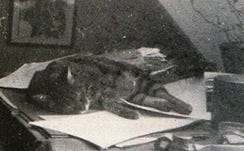Céline and Bébert: a cat Odyssey
How Céline’s feline companion and double survived exile, war, imprisonment, and cancellation
It is Bébert I want to write about—Bébert the arch-survivor and the incarnation of French cunning. Bébert would be a joy to report on. Céline is not."
— George Steiner
In the 70s, Grasset (the French publishing house) asked Céline scholar Frédéric Vitoux to write a biography of the infamous novelist. The air not yet cleared of Sartre’s fulminations, it was altogether too early for Vitoux, who joked, “what if I wrote a life of his cat instead?” This half-serious proposal was eagerly accepted, and Bébert’s canonization as a hero began.
You can love or hate Céline, you can hesitate to separate the art from the artist, but Bébert the cat compels respect from humans of all persuasions. He is an inspiring symbol of life’s resilience in the face of History. Bébert shared the writer’s better qualities and the more endearing part of his grumpiness, but none of his serious faults. Unless you want to reproach Bébert for having misplaced his stubborn loyalty. Vanity Fair admitted: “It's true its owner was a rabid anti-Semite and fascist sympathizer, but that's not the cat's fault. Try to keep some perspective, people.”
Bébert was a big stray cat of uncertain race, or as the French say, un chat de gouttière, born sometime in the 30s, on the outskirts of Paris. He probably had a rough kittenhood in the streets and a bohemian adolescence in Montmartre, before getting on in the world through adoption.
Robert Le Vigan, actor (Golgotha, Le Quai des Brumes), brought Bébert home in 1935, as a present to his Algerian fiancée Tinou. In the first edition of his biography, Vitoux wrote that Tinou abandoned the cat, but she claims to have personally entrusted Bébert to Céline’s wife, the classical dance teacher Lucette Almansor, in 1942.
Céline and Lucette lived at 4 rue Girardon, near the Moulin de La Galette. The concierge’s grandson was gravely ill, and Céline, a physician, did everything in his power to save him. It was Lucette who named the cat Bébert, after the boy. The cat went for strolls with her and observed her dance practice with deep interest. This was to last less than 2 years.
As D-Day loomed closer, Paris was no longer safe for the family. An acquaintance wrote: “Mon cher Louis-Ferdinand, no doubt you will be liquidated by the Allied forces, and you had it coming. I will not shed a single tear, I will let you die in peace. However, you should know that I am ready to take Bébert. I only care about him.”
When Céline and Lucette left for Baden Baden on June 17, 1944, Bébert refused to be left behind. At the Gare de l’Est, he boarded the train to Germany in a knapsack. Wehrmacht veterinarians had furnished him with traveling documents, but unbeknownst to them, a struggling Reich had already ratified the slaughter of all animals within its frontiers, except for non-neutered specimens of recognized breed. Bébert did not even check half a box (he’d sown his wild oats in Montmarte, and payed the price.) From the start, he was in danger, being resented the least morsel of food by the authorities, and dependent on the kindness of strangers, his own ability to win over new friends, and his innate feline resourcefulness. Even so, he tried to embrace the adventure.
Céline wanted to reach Denmark. It would take them 10 months. On their hectic travels, they visited Berlin, Lipsia, Augusta, Ulm (here Bébert witnessed the state funeral of Erwin Rommel). In November 1944, the family hopped on yet another train, cat in knapsack, destination: Sigmaringen. Nicknamed “the French Salò”, it was a meeting place for die-hard nazi supporters like Pétain, Laval, and Doriot. Céline disliked the atmosphere and the aesthetics of the town, dismissing it as “operetta”: ridiculous, grotesque, overdramatic. Bébert found few allies here, but he seems to have rather enjoyed being thrown back on his hunting skills. Vitoux, his biographer, paints it as the happiest period, from a cat’s point of view, since he had access to the Castle: “he is curious, undaunted. Passages, galleries, archways… soon, the castle holds no mystery for Bébert.”
[END OF PART ONE — TO BE CONTINUED …]






